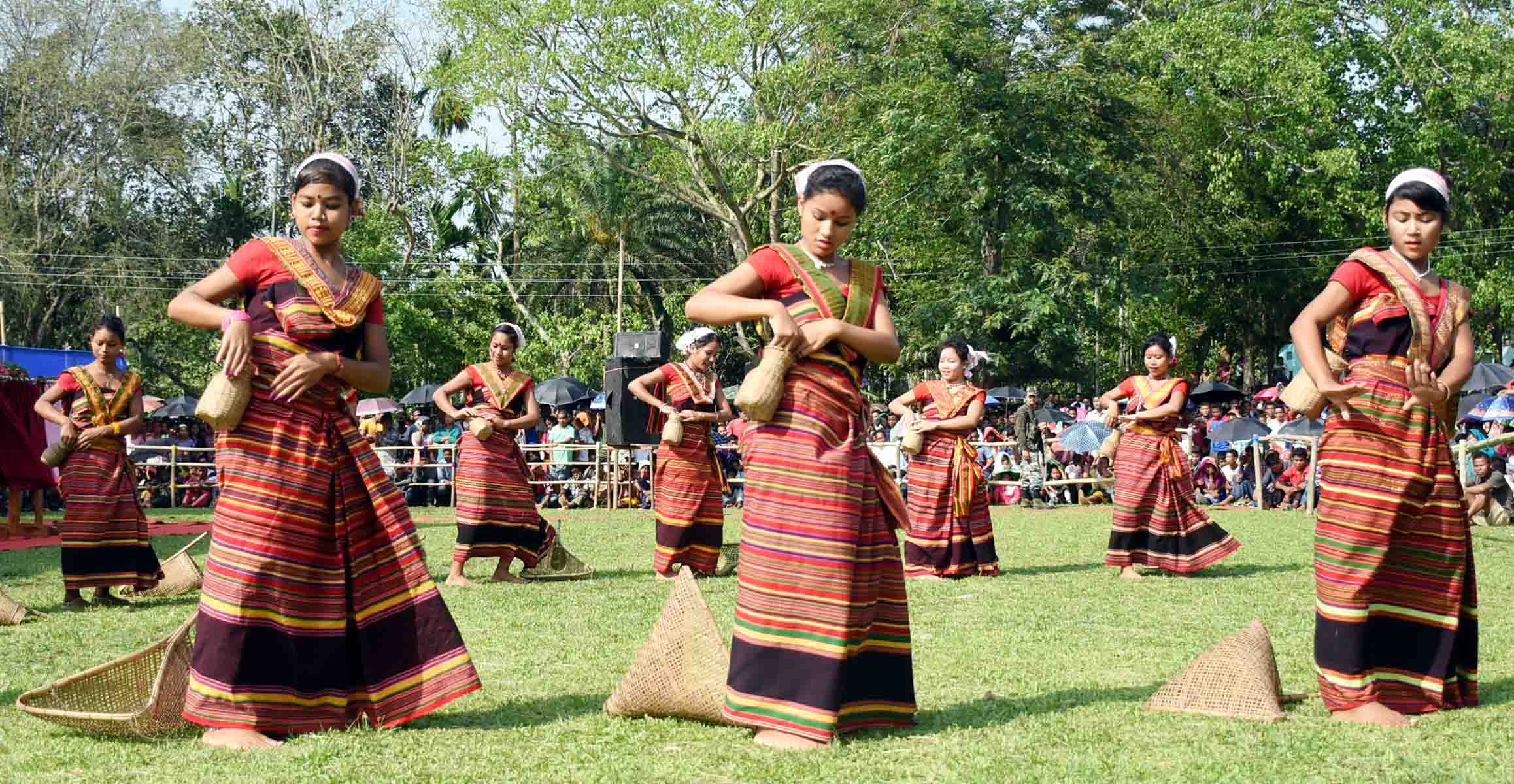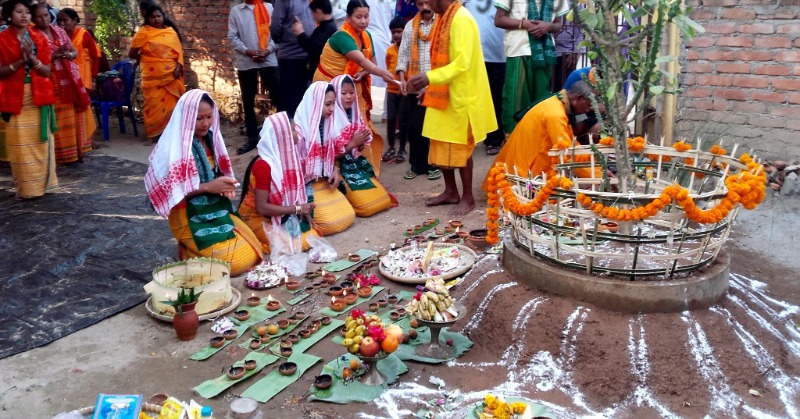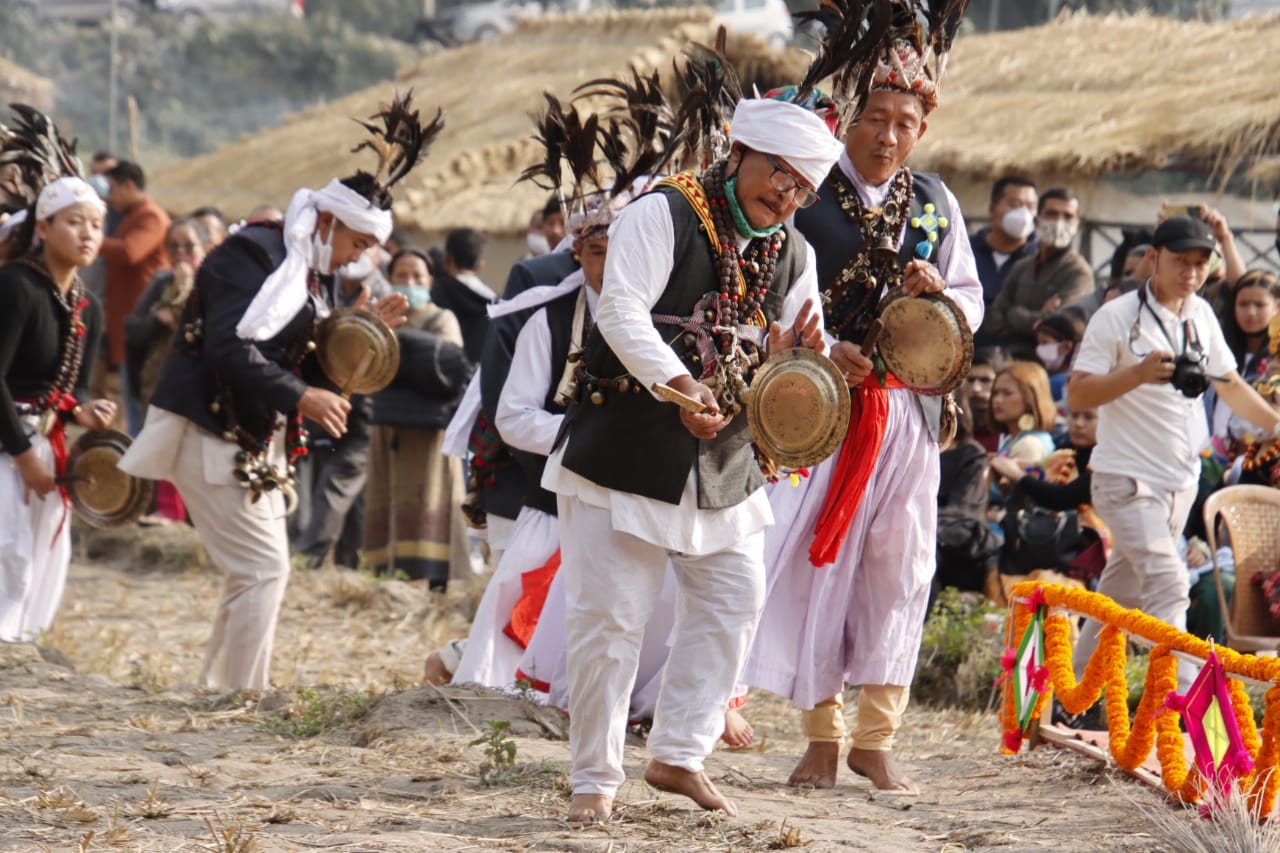Dr Ranga Ranjan Das
The Hajongs are one of the ethnic group of north eastern region settling mainly in Assam and Meghalaya and a few other parts of north eastern region apart from Bangladesh, our neighbouring country. They are recognized as scheduled tribe of both the states respectively under the provision of Indian Constitution. They still possess all the elements of traditional society and rich legal heritage through which they govern themselves without any intervention of outside agencies. They follow the norms of patrilineal society where descent, inheritance and succession trace through male line. There are wide narratives regarding their origin of name, migration to north eastern region, socio-cultural, religious and economic life apart from various norms and rules that govern their own society. Roy (Hajong) (1984: 252) observes: “The Hajong are a small tribe. During pre-Independence days the habitats of this tribe were mostly confined in the northern zone of Mymensingh and Sylhet districts stretching over from Jomkona (Sylhet District) in the east to Megadol and Karnajhora (Mymensingh) in the west. This small strip of land inhabited by the Hajongs was very fertile and rich. Agricultural products like paddy, pulses and jute were grown in abundance in this region, which made the Hajongs well to do, though not rich. A tune of happiness and self- sufficiency prevailed in the life of the Hajongs of those days and their living was simple and unsophisticated. Round about 50,000 Hajongs inhabited those areas and about three fourth of them have migrated to Assam and Meghalaya in different phases due to political and other disturbances during the erstwhile East Pakistan regime. At present majority of the Hajong population live in the State of Meghalaya, some of them in Assam, and a very negligible number in Arunachal Pradesh. In Meghalaya most of them are found in the south-west and western portion of the district of West Garo Hills and some Hajong villages are located also in the southern portion of West Khasi Hills bordering Bangladesh. In Meghalaya and Assam their approximate population is believed to be about 60,000”. Regarding the origin of the word Hajong, it is said: those who were the settlers of ancient Hajo kingdom (state) of Assam, are treated as the Hajongs. It is also said that the term Hajong is given by the Garos. According to Garo language, ha means earth and jong means insects. So, Hajong means insects of earth. They are really rooted to land for their survival and existence. They practice settled cultivation (both wet and dry) by transplantation method. The term Hajong symbolizes those people who are intimately related to land or earth for production of crops (cited in Chaudhuri 1998: 378)
Regarding the term Hajong, their origin, legends relating to migration in the context of Assam and settlement in Meghalaya, Ojah (2003: 268) bring forth valuable information under the aegis of Anthropological survey of India: “The Hajong is a scheduled tribe community of Assam. The word Hajong is derived from the word Ha meaning ‘land’ and ‘jong’ meaning insect, i.e insect of land. There is a popular legend regarding the origin of the community which is as follows: originally, they were the inhabitants of Hajo of Kamrup district. As they were the descendants of Kshattriya they fled from the wrath of Parasurama and throw away their sacred thread, concealed their caste and identified themselves as batra (keep away) and settled at Sowarkana and Tikirkilla in Garo Hills and Balat in Khasi hills. From that batra, the Hajongs have originated. They community is distributed in the districts of Goalpara, Dhubri, Kokrajhar, Nalabri, Kamrup, Darrang, Lakhimpur, Nagaon and Karbi Anglong of Assam. The main concentration of the community is found in Goalpara and Nagaon district. Outside Assam, the Hajong also inhabit in the plains of south and western border of the Garo hills of Meghalaya and the adjacent areas of south. They can speak Assamese and Bengali fluently. They use Assamese script”.
Regarding their settlement in Assam and migration to Meghalaya, affinity and socio-cultural transformation, it is reported that: “They are believed to have migrated from the North East who have settled first in Kamrup in Assam and to have later shifted to Garo Hills of Meghalaya. Dalton (1872) considered the Hajongs to be a branch of Kachari. However, the Hajong, once matrilineal and linguistically akin to the Kacharis, now demonstrates so much differences with the latter in social organization i.e. difficult to club them together” (cited in Singh 1994: 370-374). They are considered the original inhabitants of Hajo of Kamrup district, from where they migrated to different parts of Assam. The Assamese language and script are used for both inter and intra-group communication. They share the same set of gotras with their Meghalaya counterparts. In Meghalaya, they are concentrated in the southern most end and the western portion of the West Garo Hills. Some Hajong villages are situated in the East and West Khasi Hills districts bordering Bangladesh. According to the 1981 census, their population in Meghalaya is 24,331 (Singh 1994, p 370-374).
Economic practices are most important aspects of a community life. The economy of the Hajong is solely depend on agriculture. However, a major section of the members embrace various new mode of economic aspects under the influence of market economy. But traditional economic practices are still intact. They prefer settled cultivation both in Assam and Meghalaya. In an earlier study, it is revealed: “The economic basis of the community is agriculture. Weaving is an important household industry for their womenfolk. Their women weave cotton cloth for their own use and collect firewood from the nearby hills for sale. The economic activities of the Hajong include wet rice cultivation as well as the growing of cash crops like jute, mustard and pulses. The landless Hajong earn their livelihood by working as wage labourers and agricultural labourers. They are also engaged in manufacturing cane and bamboo goods (Singh 1994: 374).
They prefer to undertake settled agricultural activities in their own land. The techno operational aspects relating to wet rice cultivation involve: starting from preparation of seed-bed to harvesting or threshing and cleaning operation. Seed sowing of sali crops are usually done during sravana-bhadra (July-September) and harvested during agrahan-poush (November-January). Ahu (asu) varieties are sown in the month of asar-sraban (June-August) and harvested during the month of bhadra (August-September). They can nicely engage in their cultivation process as they have their own right on land even in Meghalaya also. It is observed that the nature of land holding is completely based on individual ownership and all of the land holding Hajongs has pattas in their name. None of them has taken possessing of akhing land (customary laws of Garos relating to land for jhum or shifting cultivation) from the neighbouring Garos (Chaudhuri 1998: 378-380).
Boiled rice is their staple food. They takes it with pulses and different varieties curries prepared in association with different seasonal vegetables, fish and meat. They do not eat pork (Ojah 2003). It is stated that rice beer is their favourite drink (Singh 1994: 370-374). But such habits are replaced by tea with the impact of Hindu religious beliefs and practices.
They have their own ethnic attire as represented by woman. Hajong woman is distinctly identified their apparel. The women wear patini like the Assamese mekhela (lower garment). The upper portion of the body is covered with pasra (a small apron) (Ojah 2003). In the villages, the Hajong women and old men wear traditional dress weaved by them. The women used a piece of cloth with broad and medium borders which have a typical colour combination known as pathanai, the men folk wears a small piece of cloth as a lower garment, known as gamcha or Vija Kapod. A custom in which the bride is expected to weave her own wedding garments still prevails among the Hajong. The men wear a headgear (pag) which consists of a heavy border of ornate geometrical patterns (Singh 1994: 370-374). Their ornaments include katabaju (armlet), nakful (nose pin), hasuli (necklace), gunjari (anklets), baghkharu (bracelet), kanful (earring), etc (ibid Ojah 2003).
The socio-religious belief and custom of the Hajong is very interesting. Their religion is an admixture of traditional beliefs and practices and also impacts of Hinduism. Various studies have examined their religious belief and practices at different intervals. The common aspects of such studies are the impact of Hinduism. Singh (1994-374) observes: “The Hajongs of Assam are the followers of the Sakta sect of Hinduism. Their important deity is Bausto. They also worship Durga and Kali.The Hajong worship ancestral deities apart from Hindu gods and goddesses, of whom the goddess Manasa is highly revered. There are three categories of priests of which their sacred specialists, the deosi and adhikari, are from their own community. The deosi worships ancestral Hajong deities, while the adhikari mainly conducts marriage ceremonies and funeral rites. A third category of priests comes from the group of Hindu Brahmans, who serve the Hajong exclusively. The religious practices, social customs and ceremonies observed by the Hajongs are influenced by two different trends of religious rites and practices, that of the neighbouring Bengali Hindu or Assamese society and the traditional beliefs and customs in their milieu”. Ojah (2003: 269-272) notes: “On the basis of religion, the Hajongs are divided into Adhikari and commoner groups. Adhikari group belongs to the Hajong priestly class, who perform the priestly work. Inter-dining between Adhikari and commoner is prohibited. But intermarriage is permitted between the members of Adhikari group and commoner groups. The Hajongs have now merged with the Hindu caste, but consider themselves to be Hindus without allotment of any caste. Though originally, they were matrilineal and matrilocal, after adopting Hinduism, they are gradually converting to patrllineal and patrilocal rules. The Hajongs are the followers of Saktaism which is a form of Hinduism. Radha and Krishna are worshipped by individual households in their family shrines. They worship their household deities for the general well being of the family. The most important deity of the community is Bausto. Generally the Bausto deity is worshipped in the month of Baishakh (April May) on Thursday of Suklapaksha. Pigeons and ducks are sacrificed to this deity. Moreover, some villagers worship pagal (god of insanity) along with the Bausto. This worship is known as Pagal-Baustopuja. They worship the Hindu gods and goddess. The most important are Kati, Shibthakur and Lakshmi. The people of the community believe goddess Kamakhya temple to be one of the great centres of Sakta worship, and pay it regular visits. They often visit Tukreswari, Sri Surya mandir, etc. on their pilgrimages. There are two categories of ritual specialists among the Hajongs. These are the deosi who officiate at the functions related to Hajong deities and the adhikari, who officiates as a priest of marriage and funeral rites as well as in worshipping deities adopted from the Hindu religion. Some Hajongs have recently abandoned the practice of animal sacrifice to the Bausto deities under the growing influence of the surrounding Hindu population of higher caste. In such cases, deities of Bausto worshipped in the same deothan or baustothan. Nowadays, they are gradually submitting more and more to Brahmanical supremacy as evidenced by the rapid disappearance of their own priests, the adhikaris”.
It is found that the religious dimensions of the Hajong are influenced by their neighbouring population in Assam and Meghalaya. It is also interesting to examine their religious aspects in the context of our neighbouring country such as Bangladesh. It is pertinent to mention here that Hajong populations are also settled in various villages under the jurisdiction of Bangladesh adjacent to Meghalaya. The Hajong population of Bangladesh still maintains own beliefs and practices. They believe on the invisible entities beyond the visible world which possess supernatural powers that have impact on the physical universe. Such entities are referred as deo. They may be harmful if they are annoyed. They need to be appeased with prayers and offerings from time to time. Assuming a definite shape of the deities, earthen effigies (thaibaan) is prepared to worship them. Various deities are associated with various aspects of social life. Baastu deo is considered as saviour of households. It is part of their custom to worship Baastu deo in a sacred place Baastu hali while constructing a new house. In Baastu Hali, they also worship other deities. Such worship can be held at family level or collective way including many families at a same time. At individual level, they worship Griha devata regularly as household god. Focusing Hajong group in Bangladesh, it is reported that “Kamakhya Devi is the deity of black magic. Presently in Bangladesh, there are three places where temples of Kamakhya Devi are located: Porakandulia village, Ghosh Gaon and Mojakhali village of Maimansing district of Bangladesh. Hajong priest are allowed to perform puja of the deity Kamakhya on every Saturday (Hajong 2020: 65-69).
Gaon bura is the part of social control mechanism. Every Hajong village comprise on gaonbura and village headman. He is elected or selected by the villagers either direct vote or nominated on the voice vote. His tenure is not fixed. It depends on the common masses of the locality. He is authorized some powers such as to convene and conduct any meeting in the village if and when it feels necessary. He also has the power to make amicably settlement of any dispute arises between the villagers. At the upper level, above village there is other mechanism of social control such as Morol (Panch Panchayat and its headman) which is basically formed with a combination of some villages. The head of panch panchayat is known as morol who is responsible to sort out problems that arise within the jurisdiction of five village. There is an interesting feature of their social structure that is gotra or nikini (clan). Among them it is strictly prohibited to marry within own clan or in the same nikini. The nikini is basically the mother’s lineage and the girl child of a family has to carry till her death, also cannot change with her husband’s nikini after her marriage. As per their custom and legal heritage, the children either male child or female child, they are to follow mother’s nikini. Within the domain of legal heritage, they classify various social crime into three main categories: serious or gross social offences, general social offences and punishment forgiveness offences. There are certain acts such as beating elder brother or sister, uncles or aunts, parents even a guru, a priest are considered as serious social offence. On the other hand, when an innocent person has been defamed or quarreled unnecessarily, it is included under general social offence. Whenever anyone misleads the society by saying false things, it is included as punishment forgiveness offence. There are various other acts which are categorically included within these three divisions. In a nutshell, they have well defined structure for social control. Indeed the Hajongs are rich in socio-cultural dimensions and possess wonderful legal of socio-legal heritage.
Selected Bibliography
Chaudhuri, Sarit (1998), ‘Agrarian situation of the Hajongs of West Garo Hills’, MK Raha and A K Ghosh edited North-East India : The Human Interface, New Delhi: Gyan Publishing House, pp, 377-388
Hajong, Arnab (2020) ‘Revitalization of Religion and Culture of the Hajongs’, in Heritage Explorer- A monthly News Bulletin, Independence Day Special Issue, Vol XIX, No 7, pp 65-69
Ojah, G.C (2003) ‘Hajong’, in K.S Singh edited People of India-Assam, Vol XV, Part I, Calcutta: Seagull books and Anthropological Survey of India
Roy, Biren (Hajong), (1998), ‘A Note on the festivals of the Hajongs’, Karotemprel Sebastian (ed), The Tribes of Northeast India, Centre for Indigenous Cultures, Shillong, pp 252-266
Singh, K. S., ed. (1994), ‘Hajong’, in The Scheduled Tribesÿþ, Calcutta, Chennai Delhi, Mumbai: Oxford University Press and Anthropological Survey of India, p. 370-374






